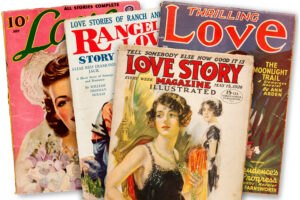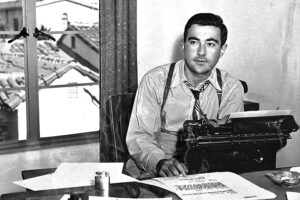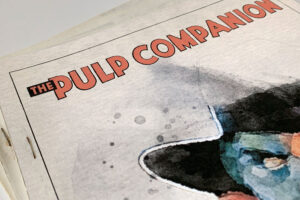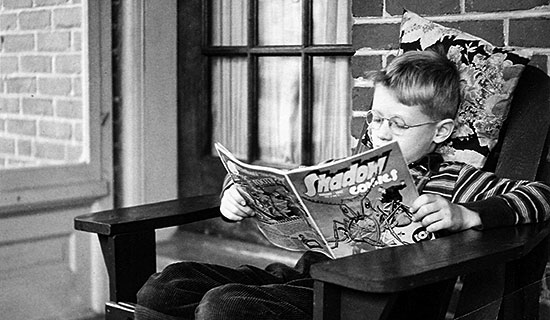
The publishing giant came late to the comic-books game, and left early.
At first glance, comic books seem like an afterthought for Street & Smith Publications.
The long-established publishing giant entered the comic-book market in 1940, two years after Superman burst onto the scene. And by the end of the decade, Street had killed its comic books, as well as its pulp magazines.
In The Shadow Scrapbook, Walter B. Gibson explains that Street & Smith’s delay in getting into the comic-book business had to do with its printing plant. Company policy was to print everything in-house, but it didn’t have the presses to handle color printing.
“We had discussed comics and the possibility of a comic strip, and during the ’30s some of the covers of The Shadow magazine, as well as inside illustrations, occasionally used pictorial sequences,” Gibson recalled in the book. “So when the firm saw other publishers forging ahead in the comic-book field, they broke their long-established rule and started one, too, even if it meant sending their color printing elsewhere.”
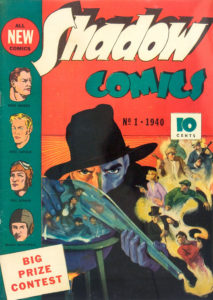
Fanzine flashback
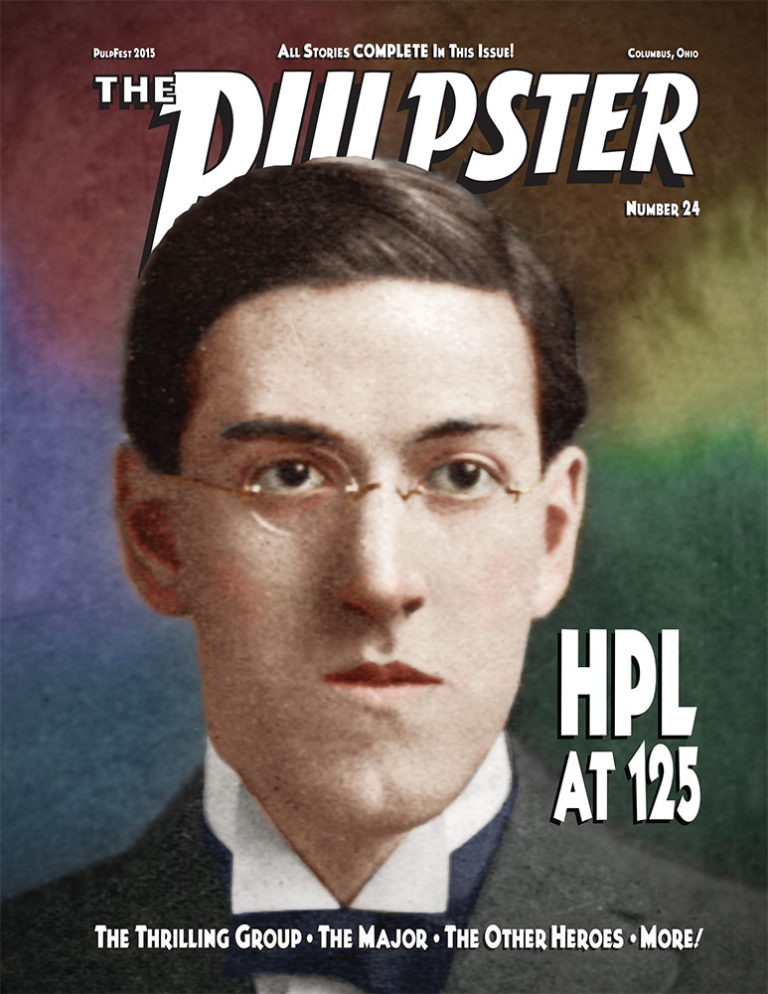 This article originally appeared in The Pulpster (#24) for PulpFest 2015.
This article originally appeared in The Pulpster (#24) for PulpFest 2015.
When Street & Smith introduced its comic-book line, “they initially went with what they knew best, that being their own pulp heroes. They probably were able to keep the costs down by keeping everything among themselves,” says Dr. Michael Vassallo, co-author of The Secret History of Marvel Comics: Jack Kirby and the Moonlighting Artists at Martin Goodman’s Empire.
Appearing 75 years ago, Shadow Comics was Street’s first comic book, hitting newsstands in January 1940. That 64-page magazine led with The Shadow, and included other pulp and dime-novel characters such as Doc Savage, Bill Barnes, Nick Carter, Iron Munro (called Aarn Munro in the pulps), Frank Merriwell, Carrie Cashin, and more.
Artwork for the Street & Smith comic books was outsourced. “To speed the output, the illustrative work was turned over to a highly efficient art studio managed by Jack Binder, while freelance artists were being contracted for special assignments,” Gibson recalled.
Binder, of course, was the older brother of pulp authors Earl and Otto Binder, who wrote under the pen-name Eando Binder. Otto Binder also wrote the initial Iron Munro script.
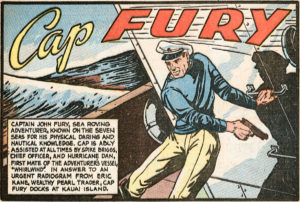
While not involved in the first Shadow Comics issue, Gibson quickly became a key scripter for many of Street’s comics.
The Street & Smith comics were varied, covering the heroes, war, sports, westerns, magic, and more. Other pulp characters appearing in them included The Avenger, Norgil the Magician, Cap Fury, and The Whisperer.
Street & Smith comics
| Here are the Street & Smith series comics listed alphabetically, with name changes indicated: | |
| Army and Navy Comics | 1940-42 |
| > Supersnipe | 1942-49 |
| Bill Barnes Comics | 1940 |
| > Bill Barnes, America’s Air Ace | 1941-43 |
| > Air Ace | 1944-47 |
| Blackstone, Master Magician Comics | 1946 |
| Doc Savage Comics | 1940-43 |
| Ghost Breakers | 1948 |
| Pioneer Picture-Stories | 1941-43 |
| Shadow Comics | 1940-49 |
| Sport Comics | 1940-41 |
| > True Sports Picture Stories | 1942-49 |
| Super-Magic Comics | 1941 |
| > Super-Magician Comics | 1941-47 |
| Top Secrets | 1947-49 |
| Trail Blazers | 1941-42 |
| > Red Dragon Comics | 1943-44, 1947-49 |
| The company also published a number of single-issue comics: | |
| Buffalo Bill Picture Stories | 1949 |
| Devil Dogs Comics | 1942 |
| Freedom Train | 1948 |
| How Aviation Cadets Are Trained | 1943 |
| How Champions Play | 1948 |
| Kid Zoo Comics | 1948 |
| Remember Pearl Harbor | 1942 |
| Science Is in the Air | 1947 |
But don’t think that their comic books were limited to pulp and dime-novel characters. Street’s comics also included funny animals, celebrities and historical figures (Buffalo Bill, Blackstone the Magician, Errol Flynn, Abbott & Costello, Joe DeMaggio), and original characters (Rocket Rooney, the Boy Rangers, the Legless Ace, the Four Musketeers, Ajax the Sun Man, Red Dragon).
Poking fun at the whole comic-book boom was Supersnipe Comics featuring the title character and his alter ego, Koppy McFad, “the boy with the most comic books in the world.” Supersnipe first appeared in Shadow Comics No. 15, and ended up with over 100 appearances in Street comics.
Street’s comic books were “a minor line that was more pulp-heavy than any other,” Vassallo says. “But comic books were forging new ground with ‘new’ heroes created specially for the comic books. While all the heroes had pulp antecedents in spirit, it was the artwork that separated the storytelling, contrasted between ‘prose’ and ‘sequential art.’ The kids wanted comic books; their fathers read pulps (primarily).
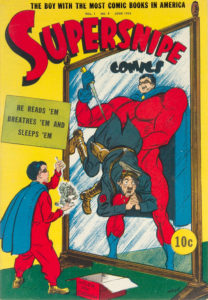
“By the time of the line’s demise, only a handful of comic-book titles were being published by S&S, along with only four pulp titles. With the changes in both the comic-book and pulp industry, I’d say it didn’t pay to continue either.”
Vassallo says that the Street & Smith line has only moderate collectible interest among golden-age comic collectors. “The pulp connection titles like the Shadow and Doc Savage probably have the most demand. The rest of the line appeared geared to a younger audience.”
“While there is some great work done by the Bob Powell studio and Edd Cartier, a lot of the art was second rate and crude,” he says. “The early work of Joe Maneely is fascinating to see flourish, though. I also liked the whimsical Supersnipe and Red Dragon.
“Overall, the line was third or fourth tier in my opinion, in spite of a lot of the material being scripted by Walter Gibson and his protege Bruce Elliot.”
Street & Smith folded its last five comics — the long-running Shadow Comics, Supersnipe Comics, True Sports Picture Stories, Top Secrets, and Red Dragon Comics — in 1949.
In an Associated Press story from April 8, 1949, S&S board chairman Allen L. Grammer explained that the company dropped the comics and pulp magazines because of a “great change in the material offered at newsstands throughout the country.”
Street & Smith left those fields to focus its attention on its “slick” magazines — Mademoiselle, Mademoiselle’s Living and Charm.
About the author
William Lampkin is editor of ThePulp.Net. He is editor and designer of The Pulpster. And, he writes the Yellowed Perils blog.


